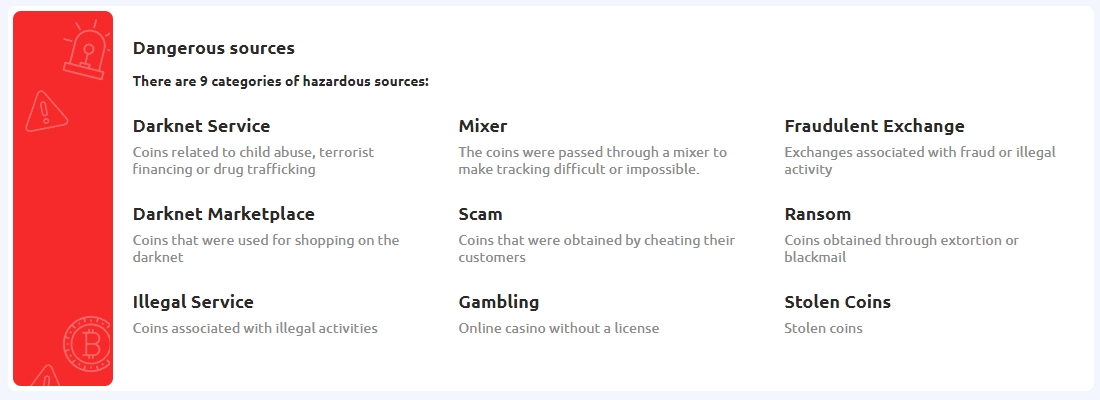Cryptocurrency mixers. What they are and how they work?
Why you should mix crypto transactions and why attackers use such services?

14.05.2022
5726
6 min
1
In early May, the US Treasury Department first imposed sanctions against the cryptocurrency mixer. According to the regulator, the Blender.io service was used by the North Korean hacker group Lazarus to launder stolen funds.
A mixer, or tumbler, is a service that allows you to mix cryptocurrencies with other users' assets to enhance the anonymity of online transactions.
Learn about the principles of mixers, their legitimacy, and who uses such services in our article.
What is a crypto mixer?
Transaction history in most blockchain networks is publicly available, any user can enter an explorer and see data about a particular address, for example, this can be done using the GetBlock explorer. Cryptocurrency wallets do not disclose any information about the owner per se, but there are already blockchain analysis methods that can trace the identity of the owner of a particular wallet. This led to a desire for users to increase their anonymity online.
There are various crypto mixers, differing in the principle of work, but all of them are used to hide the connection of coins with the identity of the owner. Such services are divided into centralized and decentralized.
The former are companies that receive the owner's cryptocurrency for a fee and then send the same amount in other coins to the owner's address. Such mixers do not provide complete confidentiality; if necessary, law enforcement agencies will be able to request any user data from private services.
Normally, centralized mixers require registration and identity verification. Such platforms charge a fee of 1-3% and it is determined randomly to make transaction tracking more difficult. Typically, private mixers use a delayed transaction, that is, the customer receives their coins in several hours or days. To enhance anonymity, the service can send cryptocurrency to the user's address from different wallets.
Decentralized mixers offer a different system of mixing coins. Such services use various smart contracts to obfuscate transactions. Essentially, such protocols allow random users to pool their coins and then redistribute them so that each participant receives the same amount but with different coins. In this system, none of the mixing participants can find out who the assets came to, and where from.
How decentralized mixers work
In the case where mixers receive “dirty” cryptocurrency, and give back “clean” one, everything is simple enough. But among such services there are many fraudsters who steal funds, so the community had to get rid of the third party. So decentralized mixers replaced intermediaries with public smart contracts.
Such protocols work as follows:
- A user deposits their cryptocurrency into the mixer's smart contract pool
- Coins are mixed with the assets of other participants in the smart contract
- The user who has been mixing their assets sends a request for coins already from another wallet. The protocols use various cryptography techniques, such as ring signatures or zk-SNARK in the withdrawal transaction, to confirm the right to the coins
- The user receives the same amount of funds, but in other coins
The main advantage of such mixers is anonymity. They do not record the history of transactions and do not allow tracking of other participants of a smart contract. On top of that, such protocols are fully public, so any user can check their code.
Popular Mixers
Tornado Cash
This is a fully decentralized cryptocurrency mixing protocol launched in 2019. Technically, Tornado Cash is a decentralized autonomous organization (DAO) that is supported by the community. The service is compatible with Ethereum, Binance Smart Chain, Polygon, Optimism, Avalanche, Arbitrum One, Gnosis Chain, and Ethereum Goerli networks.
The developers offer users two versions of Tornado Cash: Classic and experimental Nova, which supports secure transfer technology to increase the anonymity of transactions using zk-SNARK technology, which provides evidence with zero disclosure. This cryptographic protocol allows the authentication of funds without disclosing detailed information. Inter-network transfer fees are aggregated from the interest on transaction fees within the various blockchains.
Roman Semenov, the co-founder of Tornado Cash, said that the service will continue to operate in Russia despite sanctions. He stated that it is technically impossible to limit its operation in Russia, as the service is fully decentralized and all transactions in it are anonymous.
Blender.io.
This is a private service that has been offering bitcoin anonymization services since 2017. The mixer has standard BTC mixing with sending to another wallet and special transaction processing that erases some of the information about the transfer. The service adheres to a NoLog policy and does not store any user information on its servers. Transaction fees range from 0,5% to 3%.
In early May, it came under sanctions from the US Treasury Department. The department claims that Blender.io was used by hackers from North Korea to launder stolen funds.
Wasabi Wallet
This is a bitcoin wallet that is connected to the Chaumian CoinJoin mixer. The Wasabi Wallet infrastructure is technically centralized, but it is designed so that neither the owners nor the developers can de-anonymize users or steal any funds.
How to protect yourself from connection with mixers
In some cases, mixers can mix cryptocurrency with the coins of unsuspecting users. According to a study by analytics company Chainalysis, about 11% of transactions in mixers relate to illegal activity. This means that “dirty” cryptocurrency can get to unsuspecting users. In this case, cryptocurrency exchanges and other services can block the account and freeze all funds on it.
For example, the terms of service of Tether (the issuer of the USDT stabelcoin) state that the company has the right to freeze all of the user's funds if the user is associated with criminal activity or individuals/organizations from sanctions lists. Similar rules apply to other companies as well.
To reduce the risks and secure your funds, you can use the GetBlock explorer, which provides AML checks for transactions. With the service, you can get detailed information about the origin of funds and their owner, as well as assess the level of the potential risk of every single transaction.
You can see an example of a transaction from the mixer at the link:
https://getblock.net/ETH/tx/0xcfe1bc44dc5b4b0cf3381b5a5faf51cad5286fef2dbf6e9d838bee23ac2cf95d
AML services clearly recognize such transactions and classify them as high risk, along with fraud, stolen coins, and other forms of illegal activity.

You can learn more about how the GetBlock AML checks work by following this link.
Useful material?
Basics
Why Satoshi Nakamoto’s technical manifesto for a decentralized money system matters
Oct 31, 2022
Basics
Experts evaluated the development prospects of the new ecosystem and the investment attractiveness of its token
Oct 20, 2022
Basics
How to track fluctuations correctly and create an effective income strategy
Sep 13, 2022
Basics
Review of the most profitable offers from proven trading platforms
Aug 29, 2022
Basics
The Ethereum Foundation team has published a breakdown of major misconceptions about the upcoming network upgrade
Aug 18, 2022
Basics
What benefits the exchange offers, and what else is in the near future
Aug 4, 2022









 Telegram
Telegram  Twitter
Twitter